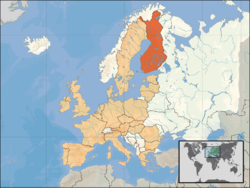Suomen tasavalta
Republiken Finland
Republic of Finland
|
|
 |
 |
|
Flag |
Coat of arms |
|
Anthem: Maamme (Finnish)
Vårt land (Swedish)
"Our Land"
|
|
|
|
 |
|
Location of
Finland (dark
green)
– on the
European
continent (light
green & dark
grey)
– in the
European Union (light
green)
— [Legend]
|
|
Capital
(and largest city) |
Helsinki
 60°10′N,
24°56′E 60°10′N,
24°56′E |
|
Official languages |
Finnish,
Swedish |
|
Recognised
regional languages |
Sami |
|
Demonym |
Finish |
|
Government |
Parliamentary republic1 |
|
- |
President |
Tarja Halonen (sd) |
|
- |
Prime Minister |
Matti Vanhanen (c) |
|
- |
Speaker |
Sauli Niinistö (nc) |
|
Independence |
from
Russian Empire |
|
- |
Autonomy |
March 29,
1809 |
|
- |
Declared |
December 6,
1917 |
|
- |
Recognised |
January 4,
1918 |
|
EU
accession |
January 1,
1995 |
|
Area |
|
- |
Total |
338,145 km² (65th)
130,558 sq mi |
|
- |
Water (%) |
10,0 |
|
|
Population |
|
- |
2008 estimate |
5,314,303[1] (111th) |
|
- |
2000 census |
5,155,000 |
|
- |
Density |
16/km² (201st)
40/sq mi |
|
GDP (PPP) |
2005 estimate |
|
- |
Total |
$163 billion (52nd) |
|
- |
Per capita |
$34,819 (12th) |
|
GDP (nominal) |
2007 estimate |
|
- |
Total |
$245.491
billion (31st) |
|
- |
Per capita |
$46,602 (12th) |
|
Gini (2000) |
26.9 (low) |
|
HDI (2007) |
▲ 0.952 (high) (11th) |
|
Currency |
Euro (€)²
(EUR) |
|
Time zone |
EET
(UTC+2) |
|
- |
Summer (DST) |
EEST (UTC+3) |
|
Internet TLD |
.fi,
.ax ³ |
|
Calling code |
+358 |
|
Finland,
officially the Republic of
Finland (Finnish: Suomi;
Swedish: Finland (help·info)),
is a Nordic country situated in
the Scandinavian region of
northern Europe. It has borders
with Sweden to the west, Russia
to the east, and Norway to the
north, while Estonia lies to its
south across the Gulf of
Finland. The capital city is
Helsinki.
Around 5.3 million people reside
in Finland, with the majority
concentrated in the southern
part of country.[1] It is the
eighth largest country in Europe
in terms of area and the most
sparsely populated country in
the European Union. The native
language for most of the
population is Finnish, a member
of the Finno-Ugric language
family most closely related to
Estonian and one of the four
official EU languages not of
Indo-European origin. The second
official language, Swedish, is
spoken by a 5.5 percent
minority.[3] Finland is a
democratic, parliamentary
republic with a mostly
Helsinki-based central
government and local governments
in 415 municipalities. Greater
Helsinki (including Helsinki,
Espoo, Vantaa and Kauniainen)
totals a million residents and a
third of the GDP. Other major
cities include Tampere, Turku,
and Oulu.
Finland was historically part of
Sweden and from 1809 an
autonomous Grand Duchy within
the Russian Empire. Finland's
declaration of independence in
1917 from Russia was followed by
a civil war, wars against the
Soviet Union and Nazi Germany,
and a period of official
neutrality during the Cold War.
Finland joined the United
Nations in 1955 and the European
Union in 1995 and participates
in the Eurozone. Finland has
been ranked the second most
stable country in the world, in
a survey based on social,
economic, political, and
military indicators.[4]
Finland has seen excellent
results in many international
comparisons of national
performance such as the share of
high-technology manufacturing,
the rate of gross domestic
product growth, and the
protection of civil liberties.



